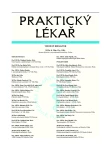Prostate cancer in the age of the da Vinci robotic radical prostatectomy
Authors:
I. Kolombo; M. Toběrný; S. Černohorský; J. Poněšický; J. Tobiáš; J. Kašík; S. Blažej; P. Beňo; J. Valdman; M. Pazdera; F. Fidler; M. Bartůněk
Authors‘ workplace:
Primář: MUD. Michal Toběrný
; Centrum robotické chirurgie a urologie Nemocnice Na Homolce Praha
Published in:
Prakt. Lék. 2009; 89(8): 420-428
Category:
Reviews
Overview
Robotic surgery with the daVinci system (Intuitive Surgical®, USA) is the most sophisticated medical technology in urology. Integration of modern computer technologies, digital imaging and robotic technologies are now bringing opportunities to improve results of surgical procedures. One of the greatest advantages (in comparison to standard laparoscopy) is that the image of the operation field is three-dimensional and magnified. Further major advantages are the instruments themselves. Laparoscopic instruments only allow for rotation and have only one joint. Robotic instruments with technology of Endowrist® not only mimic but even surpass the movements of a human hand, because all the joints are near the very tip of the instruments, allowing manoeuvres in previously inaccessible spaces. This greatly enhances surgeon dexterity and precision and decreases the number of false movements. Robotic technology is ideally suited to decrease the technical difficulty in the most demanding urooncological and reconstructive procedures.
Robotic daVinci radical prostatectomy is the new gold standard for minimally invasive surgical treatment of clinically localized prostate cancer.
Our results from the Centre of Robotic Surgery and Urology in Hospital Na Homolce, Prague also confirm the benefits for patients after daVinci prostatectomy (shorter hospital stay, quicker convalescence, better early continence and potency rate) similarly for patients after another urologic robotic surgery procedures. The learning curve for robotic surgery is much shorter than it’s laparoscopic counterpart and skills are acquired faster avoiding the need for lengthy training in minimally invasive surgery. Robotic surgery with the daVinci system has gradually switched many complex surgical procedures, such as radical prostatectomy, from open and laparoscopic to the robotic approach.
Key words:
robotic daVinci surgery, prostate cancer, prostatectomy.
Sources
1. Adam, Z., Vorlíček, J., Čermák, A. a kol. Nádorové markery. In Adam, Z., Vorlíček, J. a kol. Obecná onkologie. Brno: Masarykova universita, 2004, s. 98-107.
2. Babjuk, M., Matoušková, M., Novák, J. Zhoubné nádory prostaty. In Babjuk, M., Matoušková, M., Novák, J. Doporučené diagnostické a léčebné postupy u urologických nádorů, Praha: Galén, 2003, s. 17-27.
3. Box, G.N., Ahlering, T.E. Robotic radical prostatectomy: long-term outcomes. Curr. Opin. Urol. 2008, 18, p. 173-179.
4. Dušek, L., Mužík, J., Kubásek, M. a kol. Epidemiologie zhoubných nádorů v České republice [online]. Masarykova univerzita, [2005], [cit. 2009-1-11]. Dostupný z WWW: <http://www.svod.cz. Verze 7.0 [2007], ISSN 1802 – 8861.
5. Dvořáček, J., Šafařík, L. Nádory prostaty. In Dvořáček, J., Šafařík, L. a kol. Onkourologie. Praha: Galén a Karolinum 2005, s. 225-428.
6. Filipenský, P., Rovný, A., Katolická, J., Hulová, M. Robotika v urologii. Endoskopie 2008, 17, s. 16-19.
7. GLOBOCAN 2002. Dostupný z WWW: 8. Jarolím, J., Abrahámová, J., Buncová, M. a kol. Kostní metastázy. Program urologie a onkologie Elektronické Univerzity. [on line]. EUNI 2007. Dostupný na WWW: 9. Klener, P., Abrahámová, J. Karcinom prostaty. In Klener, P. Klinická onkologie. Praha: Galén, 2002, s. 452-460.
10. Kőhler, O., Kočárek, J., Belej, K. a kol. Roboticky asistovaná transperitoneální nervy šetřící radikální prostatektomie. Abstrakta: Výroční konference České urologické společnosti ČLS JEP, České Budějovice 11.-13.10.2006, Abstrakt 34. Čes. Urol. 2006, 10, 2, s. 32.
11. Kolombo, I., Hanuš, T., Toběrný, M., a kol. Prostata v éře robotických technologií. Praha: Pears Health Cyber, s.r.o., 2008, s. 1-322. ISBN 978- 80-904168-0-2.
12. Kolombo, I., Kolombová, J., Dvořáček, J., Hanuš, T. Skeletální postižení v uroonkologii. Praha: Galén, 2005, s. 1-171. ISBN 80-7262-342-7.
13. Kolombo, I., Toběrný, M., Černohorský, S. a kol. DaVinci laparoskopická radikální prostatektomie. Endoskopie 2008, 17, s. 25-34.
14. Kolombo, I., Toběrný, M., Černohorský, S. a kol. DaVinci robotická radikální prostatektomie - naše současná technika a výsledky. Endoskopie 2009, 18, s. 25-34.
15. Kolombo, I., Toběrný, M., Černohorský, S. a kol. Laparoskopické roboticky asistované operace ledvin. Endoskopie 2008, 17, s. 35-42.
16. Pacík, D. Karcinom prostaty a benigní hyperplazie prostaty. [on line]. Program urologie Elektronické Univerzity. EUNI 2007. Dostupný na WWW: <http://www.euni.cz>
17. Študent, V., Grepl, M., Král, M., Hartmann, I. Má vyšetření PSA stále význam při vyhledávání karcinomu prostaty? Urol. pro Praxi 2006, 5, s. 214-218.
18. Tewari, A., Raman, J.D., Chang, P., et al. Long-term survival probability in men with clinically localized prostate cancer treated either conservatively or with definitive treatment (radiotheray or radical prostatectomy). Urology 2006, 68, p. 1268-1274.
19. ÚZIS ČR - Ústav zdravotnických informací a statistiky ČR - Zhoubné nádory v roce 2006 [on line]. Dostupný na WWW: www.uzis.cz/ download_file.php?file=3518.
Labels
General practitioner for children and adolescents General practitioner for adultsArticle was published in
General Practitioner

2009 Issue 8
Most read in this issue
- The calcium score: helper or a bad counsellor in diagnostics of chest pain suspected of coronary origin
- Prostate cancer in the age of the da Vinci robotic radical prostatectomy
- Prevention of venous thrombosis (phlebothromboprophylaxis) in clinical practice
- Incidence of pulmonary embolism in females aged 15–25 years in relation to oral contraception use (Results of a five-year study)
